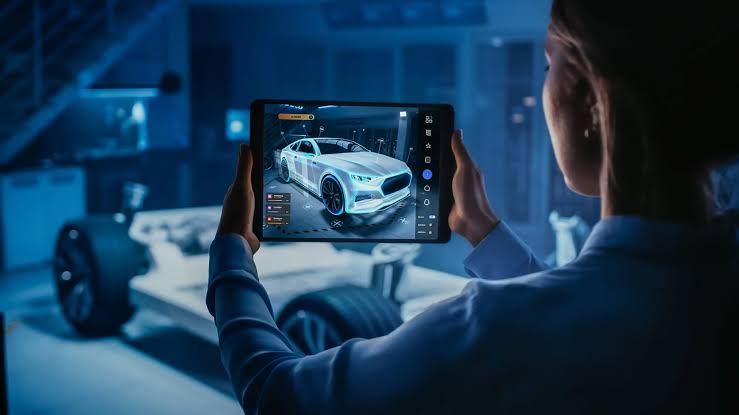
AR/VR for Product Demos, Training, and Customer Experience
AR (Augmented Reality) and VR (Virtual Reality) are transforming how businesses showcase products, train employees, and engage customers. AR enriches the real world with digital overlays, while VR offers immersive simulations. These technologies make product demos more interactive, training more effective, and customer experiences more personalized. Industries like retail, healthcare, aviation, and manufacturing are rapidly adopting AR/VR to reduce costs and improve efficiency.
✨ Raghav Jain

Introduction
In the ever-evolving world of technology, businesses are constantly searching for innovative ways to connect with customers, train employees, and showcase products. Augmented Reality (AR) and Virtual Reality (VR) have emerged as powerful tools that transform traditional interactions into immersive, engaging, and effective experiences.
Whether it's letting customers explore a product virtually before purchase, providing realistic training environments, or enhancing customer service through interactive simulations, AR and VR are changing the game across industries. What once seemed futuristic is now becoming essential in business strategies.
This article explores how AR and VR are revolutionizing product demonstrations, employee training, and customer experience, along with real-world examples and future possibilities. The transformative power of Augmented Reality (AR) and Virtual Reality (VR) extends far beyond the realm of entertainment, revolutionizing critical business functions such as product demonstrations, training, and customer experience. These immersive technologies are fundamentally changing how companies engage with their products, employees, and customers, offering unprecedented levels of interactivity, realism, and efficiency. By bridging the gap between the physical and digital worlds, AR and VR create dynamic and engaging environments that enhance understanding, improve retention, and foster deeper connections, ultimately driving significant business value and setting new benchmarks for engagement in an increasingly competitive landscape. The ability to simulate complex scenarios, visualize intricate details, and provide hands-on, risk-free learning opportunities makes AR and VR indispensable tools for businesses seeking to innovate and excel in the modern economy.
In the domain of product demonstrations, AR and VR offer a paradigm shift from traditional static presentations, enabling companies to showcase products in ways that are both compelling and highly interactive. For large, complex, or customizable products – such as industrial machinery, real estate properties, or intricate automotive components – physical demonstrations can be logistically challenging, expensive, or even impossible. VR allows for the creation of fully immersive virtual showrooms or environments where potential customers can explore a product in 3D, at true 1:1 scale, from any angle, and even interact with its various features and functionalities. Imagine a prospective homeowner taking a virtual walkthrough of a property before it's built, customizing finishes and layouts in real-time, or an engineer disassembling and inspecting a virtual engine down to its smallest bolt. This level of immersive interaction fosters a profound sense of presence and ownership, leading to enhanced engagement and accelerated purchasing decisions. Augmented Reality, on the other hand, overlays digital information onto the real world, allowing customers to visualize products within their own environment. AR apps enable users to "try before they buy" – for instance, virtually placing furniture in their living room to see how it fits, or trying on clothing and makeup digitally, reducing uncertainty and minimizing returns. This blend of the physical and virtual makes product demonstrations more personalized, accessible, and impactful, transcending geographical barriers and providing a richer understanding than brochures or 2D images ever could. The ability to customize virtual products on the fly, showcase internal workings through X-ray vision, or demonstrate product benefits through simulated scenarios empowers sales teams and captivates potential buyers, leading to higher conversion rates and stronger brand recall.
For training and development, AR and VR offer unparalleled advantages in terms of effectiveness, safety, and cost efficiency, particularly for complex, high-risk, or hands-on tasks. Traditional training methods, often involving physical equipment, travel, and classroom instruction, can be expensive, time-consuming, and carry inherent risks. VR provides a fully immersive, simulated environment where trainees can practice skills, operate machinery, and respond to critical situations in a risk-free setting. This is invaluable for industries such as healthcare (simulating surgeries, emergency procedures), manufacturing (operating complex machinery, assembly processes), aviation (flight simulators), and emergency services (disaster response scenarios). Trainees can make mistakes and learn from them without real-world consequences, fostering muscle memory, improving decision-making under pressure, and building confidence. Studies consistently show that VR training leads to significantly higher knowledge retention rates and faster skill acquisition compared to traditional methods. AR enhances on-the-job training by overlaying digital instructions, schematics, or real-time guidance directly onto physical objects or environments. Technicians can wear AR smart glasses to receive step-by-step instructions for repairs, assembly, or maintenance procedures, effectively acting as a digital mentor. This reduces training time, minimizes errors, and allows less experienced workers to perform complex tasks with expert guidance, bridging the skills gap and improving operational efficiency. Both AR and VR facilitate remote training and collaboration, enabling geographically dispersed teams to learn together in shared virtual spaces, reducing travel costs and ensuring consistent training standards across global operations.
Finally, AR and VR are revolutionizing customer experience (CX) by creating more engaging, personalized, and memorable interactions that deepen brand loyalty and satisfaction. In retail, AR-powered virtual try-on features for clothing, accessories, and cosmetics allow customers to visualize how products look on them without the need for physical interaction, enhancing convenience and reducing purchase hesitation. Virtual showrooms provide immersive shopping experiences where customers can browse and interact with products at their own pace, mimicking the in-store experience from the comfort of their home. Beyond direct product interaction, AR and VR can be used to create immersive brand storytelling experiences, allowing customers to delve into a brand's history, values, or manufacturing processes in an engaging way. For customer support, AR-powered remote assistance enables experts to guide customers through troubleshooting or repair processes by drawing annotations or highlighting specific areas on the customer's real-world view via their smartphone camera or AR glasses. This real-time visual guidance simplifies complex issues, reduces the need for on-site visits, and significantly improves first-call resolution rates, leading to higher customer satisfaction. Furthermore, AR and VR can be leveraged for gamified experiences, loyalty programs, and interactive advertising campaigns that captivate audiences and create a stronger emotional connection with the brand. The ability to personalize experiences based on user preferences and behavior, coupled with the novelty and interactivity of these technologies, makes the customer journey more enjoyable, efficient, and ultimately, more rewarding, distinguishing brands in a crowded marketplace and cultivating lasting customer relationships.
Understanding AR and VR
Before diving into their applications, it’s important to understand what AR and VR actually are:
- Augmented Reality (AR) overlays digital content (like images, videos, or animations) onto the real world using smartphones, tablets, or AR glasses.
- Virtual Reality (VR) creates a completely immersive environment that replaces the physical world using headsets like Oculus Rift, HTC Vive, or Meta Quest.
While AR enhances reality, VR replaces it—both providing unique opportunities for brands to engage and educate.
AR/VR in Product Demonstrations
Traditional product demos often involve printed brochures, videos, or in-person trials. But these methods have limitations, especially when customers are remote or the product is complex. AR and VR solve these problems by offering interactive and lifelike demonstrations.
1. Virtual Product Walkthroughs
VR enables users to explore a product in a 3D environment. Whether it's walking through a new car model, examining machinery from all angles, or testing features in real-time, VR offers a deep understanding of the product’s look and functionality.
Example: Automotive companies like Audi and BMW use VR showrooms where customers can explore cars virtually without needing a physical inventory.
2. AR Try-Before-You-Buy
AR allows customers to see how a product would look or function in their own environment. From furniture and home appliances to makeup and glasses, AR removes uncertainty from the buying decision.
Example: IKEA’s AR app lets customers visualize how furniture fits into their rooms before making a purchase.
3. Reducing Return Rates
One of the biggest advantages of AR/VR demos is the reduction in return rates. By setting accurate expectations, customers are less likely to be disappointed post-purchase.
AR/VR in Employee Training
Training new employees, especially in technical or high-risk roles, can be time-consuming and expensive. AR and VR provide immersive training tools that improve learning outcomes, reduce costs, and enhance safety.
1. Simulated Learning Environments
VR training modules simulate real-world scenarios where employees can practice without risks. This is especially useful in fields like healthcare, aviation, manufacturing, and military.
Example: Medical students use VR simulations to practice surgeries, improving precision and reducing errors in real procedures.
2. Onboarding and Soft Skills Training
AR/VR can also be used for customer service training, leadership development, or handling workplace scenarios like conflict resolution or diversity training.
Example: Walmart has deployed VR training across stores to prepare employees for Black Friday rushes, helping them develop calm and effective responses under pressure.
3. Gamified Learning
By adding gamification elements to AR/VR training—such as scores, badges, and progress levels—companies can boost engagement and retention of information.
AR/VR in Enhancing Customer Experience
Customer experience is now a major competitive differentiator. AR/VR offers companies new ways to personalize, entertain, and add value to each customer interaction.
1. Virtual Customer Service Assistants
Imagine a customer using their smartphone to scan a product and instantly seeing a holographic assistant guide them through features and FAQs. AR-powered assistants reduce friction and improve satisfaction.
Example: Sephora’s AR mirror allows users to try on makeup virtually, while also giving beauty tips and product information.
2. Immersive Brand Storytelling
Brands can use VR to take customers on a journey—perhaps showing the origins of a product, behind-the-scenes production, or the story of the brand. This builds emotional connections and trust.
Example: TOMS Shoes created a VR experience showing the impact of their One-for-One donation model in Peru, allowing customers to “walk in the shoes” of beneficiaries.
3. Personalized Shopping Experiences
AR apps can scan a user's face, body type, or preferences to offer curated product recommendations. This kind of personalization boosts conversions and customer loyalty.
Benefits of AR/VR Across These Applications
- Increased Engagement: Interactive content grabs attention and encourages active participation.
- Higher Retention Rates: Immersive learning experiences improve memory and understanding.
- Cost Savings: Reduces the need for physical setups, trainers, and product shipping.
- Remote Accessibility: Anyone can access AR/VR tools from anywhere in the world.
- Better Data Analytics: User interactions within AR/VR platforms can provide valuable insights for optimization.
Challenges and Considerations
While AR/VR is promising, it comes with its challenges:
- Cost of Development: High-quality AR/VR content and hardware can be expensive to produce.
- Device Compatibility: Not all customers or employees may have access to the necessary technology.
- User Comfort: VR can sometimes cause motion sickness or discomfort.
- Content Relevance: Poorly designed AR/VR experiences can confuse or frustrate users if not tailored to specific needs.
To succeed, businesses must ensure that AR/VR adds real value rather than just being a novelty.
Future Outlook: What’s Next for AR/VR?
With advancements in AI, 5G, and wearable tech, AR and VR are poised to become more mainstream. Future innovations may include:
- Mixed Reality (MR): Blending real and virtual worlds in even more seamless ways.
- Haptic Feedback: Allowing users to “feel” virtual textures and resistance.
- AR Glasses and Wearables: Moving beyond smartphones to hands-free experiences.
As technology becomes more affordable and accessible, expect AR/VR to be integrated into everyday business functions—from shopping to training to customer support.
Conclusion
AR and VR are no longer futuristic gimmicks—they are powerful, practical tools that elevate product demos, training, and customer experience. Businesses adopting these technologies can offer more engaging, efficient, and personalized interactions that meet modern consumer expectations.
Whether it’s helping a customer try out a product from the comfort of their home, training employees in a risk-free virtual environment, or creating emotional brand connections, AR and VR offer endless possibilities.
To fully leverage AR and VR, businesses should focus on thoughtful implementation, clear goals, and user-centered design. With these technologies in your toolkit, the future of engagement is not just visual—it's immersive.
Q&A Section
Q1: What is AR/VR technology and how are they different?
Ans: Augmented Reality (AR) adds digital elements to the real world using devices like smartphones or glasses, while Virtual Reality (VR) creates a completely immersive digital environment using VR headsets.
Q2: How is AR/VR used in product demonstrations?
Ans: AR/VR allows customers to visualize and interact with products in a 3D virtual space, helping them understand features, size, and usability without physically handling the item.
Q3: Why is AR/VR becoming popular in employee training?
Ans: AR/VR creates realistic, hands-on training simulations, improving learning retention and safety, especially in fields like manufacturing, healthcare, and aviation.
Q4: How does AR/VR enhance the customer experience?
Ans: It engages customers with interactive, personalized experiences—like virtual try-ons or immersive product previews—making the shopping process more exciting and informative.
Q5: What industries are using AR/VR for training?
Ans: Industries such as healthcare, military, automotive, and construction use AR/VR to simulate real-life situations for better skill development and safer practice.
Q6: Can AR/VR reduce costs for businesses?
Ans: Yes, by replacing physical prototypes and on-site training with virtual environments, AR/VR saves time, resources, and travel expenses.
Q7: What role does AR play in online shopping?
Ans: AR allows customers to "try before they buy" by virtually placing products in their space or trying them on, which increases confidence and reduces returns.
Q8: How does VR improve product understanding?
Ans: VR enables users to explore the product’s functionality and features in detail through interactive walkthroughs, helping them make more informed purchase decisions.
Q9: What are the challenges in adopting AR/VR?
Ans: High development costs, hardware limitations, and the need for skilled developers can be barriers for businesses looking to implement AR/VR.
Q10: What is the future potential of AR/VR in business?
Ans: As technology advances and becomes more affordable, AR/VR will become a standard tool for training, marketing, customer engagement, and remote collaboration across industries.
Similar Articles
Find more relatable content in similar Articles

The Future of Cybersecurity: A..
The future of cybersecurity i.. Read More

The Role of Robotics in Streng..
Robotics plays a vital role i.. Read More

Data privacy regulations (GDPR..
Data privacy regulations such.. Read More

Rising Cyber Crimes: Latest T..
Cyber crimes are rapidly grow.. Read More
Explore Other Categories
Explore many different categories of articles ranging from Gadgets to Security
Smart Devices, Gear & Innovations
Discover in-depth reviews, hands-on experiences, and expert insights on the newest gadgets—from smartphones to smartwatches, headphones, wearables, and everything in between. Stay ahead with the latest in tech gear
Apps That Power Your World
Explore essential mobile and desktop applications across all platforms. From productivity boosters to creative tools, we cover updates, recommendations, and how-tos to make your digital life easier and more efficient.
Tomorrow's Technology, Today's Insights
Dive into the world of emerging technologies, AI breakthroughs, space tech, robotics, and innovations shaping the future. Stay informed on what's next in the evolution of science and technology.
Protecting You in a Digital Age
Learn how to secure your data, protect your privacy, and understand the latest in online threats. We break down complex cybersecurity topics into practical advice for everyday users and professionals alike.
© 2025 Copyrights by rTechnology. All Rights Reserved.